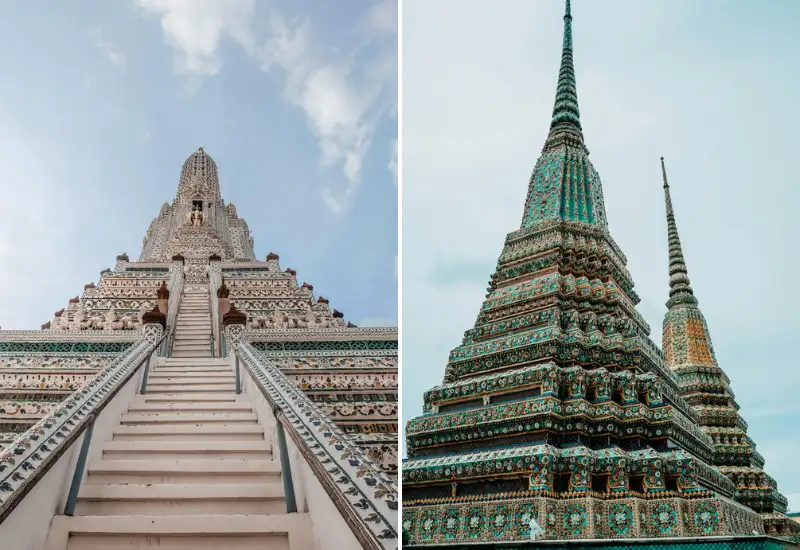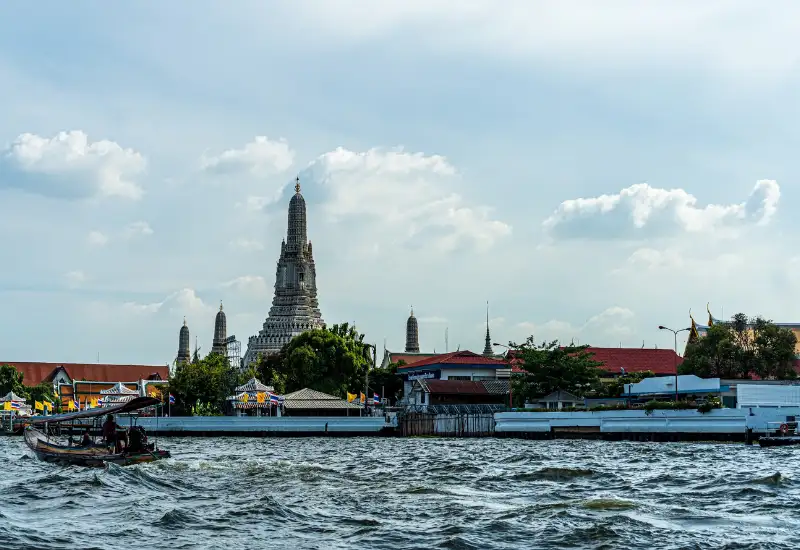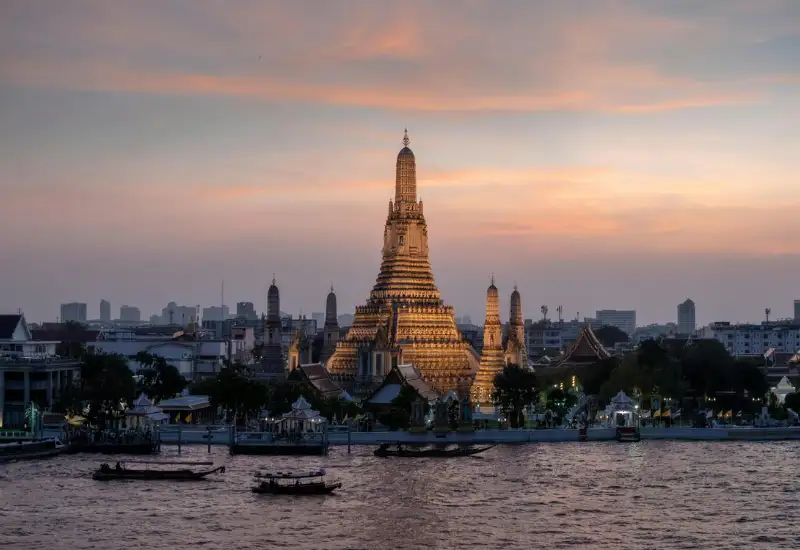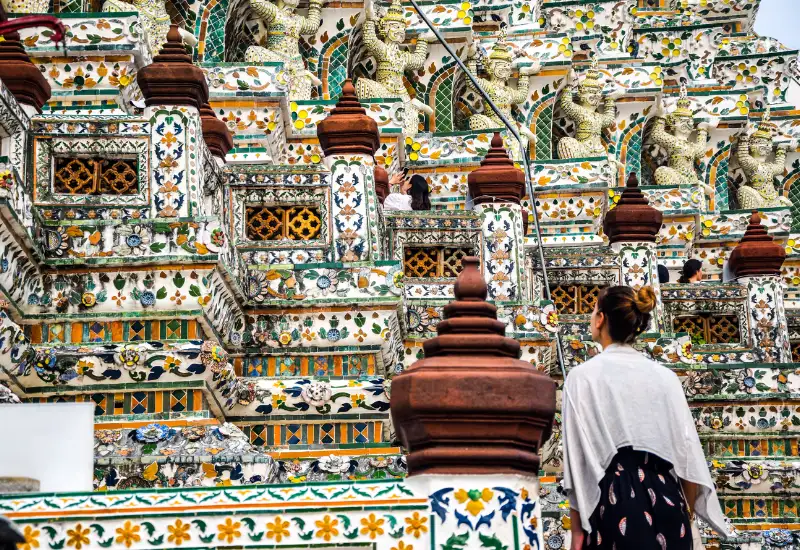Looking for a captivating destination steeped in Thai culture? Wat Arun, also known as the Temple of Dawn, is a perfect choice. With its distinctive architecture and rich history, Wat Arun stands as one of Bangkok’s most iconic landmarks.
Introduction to Wat Arun
- Where is Wat Arun located? Perched majestically along the poetic Chao Phraya River, Wat Arun is one of Bangkok’s most recognizable symbols. Situated on the west bank, it draws visitors with its serene beauty and striking architecture, easily spotted from afar.
- History and meaning of the Name “Temple of Dawn”: The name Wat Arun is inspired by Arun, the Hindu god of dawn. Legend has it that in the 18th century, King Taksin saw the temple at sunrise, its radiant glow marking it as a symbol of new beginnings.
- Wat Arun’s Role in Thai culture and religion: More than a sacred place of worship, Wat Arun is deeply tied to Bangkok’s history. It represents the blend of Buddhism and Thai spiritual life and is a key site during major festivals in Thailand.
The unique architecture of Wat Arun
A Fusion of Thai and Khmer Influences
Wat Arun shines with a harmonious blend of Thai and Khmer architectural styles. Its towers are adorned with colorful porcelain and glass fragments, creating a dazzling effect, especially under sunlight.
The soaring Central Prang
The central prang, rising 70 meters, is the architectural centerpiece, symbolizing Mount Meru—the cosmic center in Hindu-Buddhist beliefs. Visitors flock here to pray for peace and prosperity.

Intricate porcelain patterns and carvings
The towers are decorated with repurposed Chinese porcelain, meticulously arranged into floral and animal motifs. This craftsmanship reflects the dedication and skill of ancient artisans.
Wat Arun Through Time
- Formation and Growth: Originating in the Ayutthaya period, Wat Arun flourished under King Taksin and King Rama II.
- Major Restorations: Over centuries, Wat Arun has undergone several restorations to preserve its original beauty and strengthen its structure against time’s wear.
- Wat Arun in Thailand’s historical context: Once home to the Emerald Buddha before its move to Wat Phra Kaew, Wat Arun played a pivotal role in establishing Bangkok as the capital.

Highlights of visiting Wat Arun
- Steep Stairs and Climbing the Central Prang: Climbing the steep stairs to the prang is a challenge but rewards you with an up-close view of the temple’s grandeur.
- Panoramic Views of Bangkok: From the top, enjoy sweeping views of the Chao Phraya River and bustling Bangkok—an unforgettable experience.
- Exploring the Temple Grounds and Sacred Statues: The grounds are dotted with Buddha statues, each with unique significance, appealing to lovers of art and culture alike.
Wat Arun at Dawn and Dusk
- Radiant Beauty at Sunrise: At dawn, sunlight reflects off the porcelain towers, creating a serene, shimmering spectacle.
- Poetic Charm at Sunset: As the sun sets, Wat Arun takes on a mystical glow, evoking romance and reverence by the river.
- Why It’s Called the “Temple of Dawn”: The temple’s brilliance in the morning light perfectly justifies its poetic name.
Cultural Experiences at Wat Arun
- Festivals and religious ceremonies: Wat Arun hosts major events like Vesak, drawing crowds of devotees and visitors.
- Mythical stories: Every corner of Wat Arun holds intriguing legends, adding to its enigmatic allure.
- Spiritual significance: Beyond sightseeing, visitors come to pray for blessings and good fortune.
Tips for stunning photos at Wat Arun
- Must-Have Angles: Capture the central prang from the east bank of the Chao Phraya for the best lighting.

- Timing for Perfect Shots: Shoot at dawn or dusk to harness the natural glow.
- Outfits and Poses: Opt for light, elegant clothing to complement the temple’s sacred ambiance.

Practical information for visiting Wat Arun
- Hours and Admission: Open from 8:00 AM to 6:00 PM; entry costs about 100 Baht.
- Rules and Etiquette: Wear modest clothing and keep noise low to respect the sacred space.
- Amenities: Nearby eateries offer delicious Thai cuisine for a post-visit treat.
Getting to Wat Arun
- Transportation Options: Take a ferry from Tha Tien pier for a quick, scenic ride, or try a tuk-tuk for fun.
- Suggested Routes from Central Bangkok: Wat Arun is close to landmarks like Wat Pho and the Grand Palace, making it easy to combine visits.
- Tips for River Ferry Tickets: Buy tickets at official booths to avoid overcharges.
Pairing Wat Arun with nearby attractions
- Wat Pho: A short ferry ride away, Wat Pho houses Thailand’s largest Reclining Buddha.
- Grand Palace and Wat Phra Kaew: Just minutes away, explore the heart of Thai royalty and culture.
- Asiatique Night Market: End your day with vibrant shopping and Thai street food at this lively market.
Tips for a perfect visit
- Best time to visit: November to February offers cool, pleasant weather.
- What to bring: Pack water, sunscreen, and comfy shoes for easy exploration.
- What to avoid: Don’t climb or touch Buddha statues, and maintain reverence throughout.
Wat Arun is more than a Bangkok landmark—it’s a gateway to Thailand’s rich culture, history, and spirituality. Come experience its timeless beauty for yourself!
